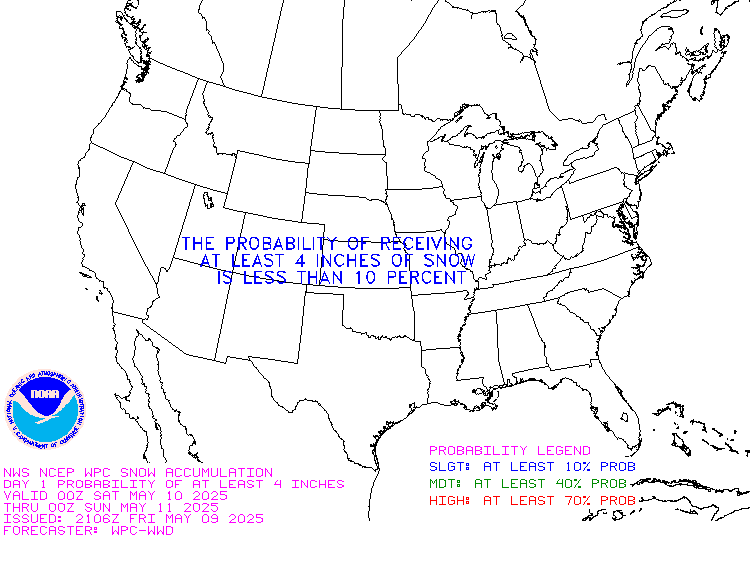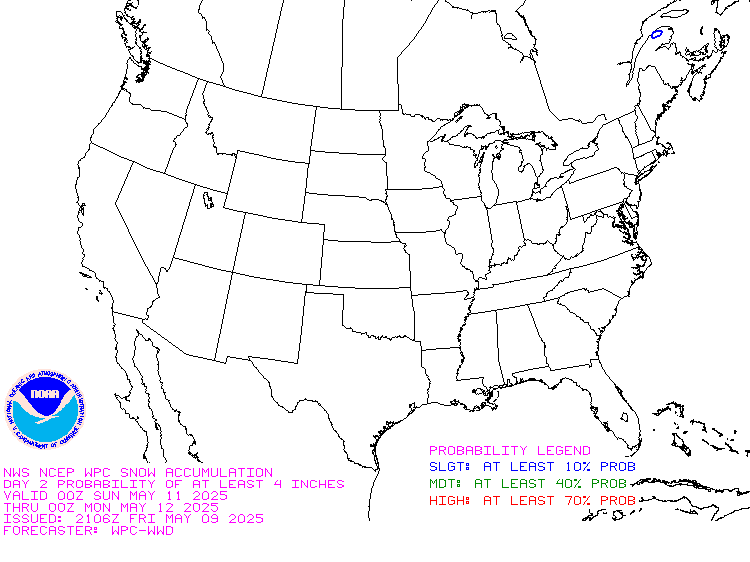It is difficult to find a more comprehensive Weather Outlook anywhere else with the ability to get a local 10-day Forecast also.
This article focuses on what we are paying attention to in the next 48 to 72 hours. The article also includes weather maps for longer-term U.S. outlooks and a six-day World weather outlook which can be very useful for travelers.
First the NWS Short Range Forecast. The afternoon NWS text update can be found here but it is unlikely to have changed very much. The images in this article automatically update.
Short Range Forecast Discussion
NWS Weather Prediction Center College Park MD
312 AM EST Mon Mar 04 2024
Valid 12Z Mon Mar 04 2024 – 12Z Wed Mar 06 2024…Increasing shower and thunderstorm chances ahead of a slow moving cold
front through the Midwest, Mississippi Valley, and Southern Plains Monday,
and the Ohio Valley and Southeast Tuesday……Another coastal storm is forecast to bring a new round of rain to the
Mid-Atlantic Monday and New England Tuesday……Weather remains unsettled for northern portions of the West with
additional very heavy snowfall expected for higher mountain elevations……Much above average, Spring-like temperatures for much of the
central/eastern U.S.; wildfire threat remains elevated Monday for the
southern High Plains…An almost quasi-stationary cold front extending southwestward from the
Great Lakes into the central/southern Plains will make slow progress
through the day Monday as ridging remains in place to the East. The
stagnant pattern will allow for additional moist return flow from the Gulf
today that will bring increasing shower and thunderstorm chances across
portions of the Midwest, Mississippi Valley, and Southern Plains compared
to Sunday, especially by Monday night. Some moderate to locally heavy
rainfall is possible along with an isolated threat for some severe
thunderstorms. Greater moisture closer to the central/western Gulf Coast
may lead to some more intense downpours from eastern Texas into the Lower
Mississippi Valley, with an isolated threat for flash flooding. A
relatively greater threat for a few more scattered instances of flash
flooding will exist over southeastern Louisiana where the combination of
repeated, back-building thunderstorms producing heavy downpours exists,
and a Slight Risk of Excessive Rainfall (level 2/5) has been introduced
for the area. The front will begin to make faster eastward progress by
Tuesday, bringing shower and thunderstorm chances into the Ohio/Tennessee
Valleys and Southeast. The chances for heavier rainfall will follow a
similar pattern for Monday, with more moderate rainfall for northern
locations and a greater chance for locally heavier rainfall and an
isolated instance or two of flash flooding from the Lower Mississippi
Valley into the Southeast. A Slight Risk of Excessive Rainfall will also
remain in effect for southeastern Louisiana as storms linger. To the east,
another coastal low pressure system is expected to deepen/better organize
along the Carolina coast Monday, bringing increasing shower chances
spreading northward into the Mid-Atlantic Monday and New England Tuesday.
Some moderate to locally heavy rainfall will be possible, particularly for
coastal locations of the Carolinas and Mid-Atlantic Monday.An energetic upper-level jet stream and another low pressure/frontal
system approaching the West Coast will keep unsettled weather in place
over northern portions of the West the next couple of days. Additional
heavy higher elevation, mountain snowfall is expected over the southern
Cascades into the northern Sierra through Monday. Moisture spreading
inland will help enhance snowfall over portions of the northern Great
Basin Monday and into the northern Rockies Tuesday as well, particularly
for southern Idaho into western Wyoming. Snowfall will also linger into
the northern Cascades and central Rockies through Monday with generally
lighter amounts expected away from the influx of greater moisture. While
most of the accumulating snowfall should be limited to higher elevations,
portions of southern Oregon in particular will likely see at least a few
inches for inland lower elevation/valley locations as colder air pushes
southward and snow levels lower. Some moderate to locally heavy rainfall
is expected for coastal locations of the Pacific Northwest/northern
California, particularly near the California/Oregon border.Widespread much above average, Spring-like high temperatures will persist
across the central/eastern U.S. to start the upcoming work week. The
greatest anomalies of 25-35 degrees will focus on the middle Mississippi
Valley northeastward into the Great Lakes and Ohio Valley Monday. Numerous
daily record-tying/breaking highs are possible as temperatures reach into
the 70s for most locations. The cold front pushing through the Midwest
will bring temperatures down into the 50s and 60s for the middle
Mississippi Valley into the upper Great Lakes Tuesday, though still above
average. Forecast highs range in the 70s and 80s for the southern Plains
Monday and Tuesday. Persistently dry conditions accompanied by lee
troughing and gusty winds will keep the threat for wildfires elevated
along portions of the southern High Plains according to the Storm
Prediction Center at least through Monday. Along the East Coast, highs are
forecast to range between the 40s and 50s for New England, 50s and 60s for
the Mid-Atlantic, and 70s to low 80s for the Southeast/Florida. In the
West, highs will remain cooler and below average, ranging from the 30s and
40s in the Pacific Northwest and much of the Interior West, 50s in
northern/central California, 60s in southern California, and 60s and 70s
into the Desert Southwest. The coldest spot in the country will be in the
northern Rockies/adjacent High Plains, where highs will be in the teens
and 20s.
To get your local forecast plus active alerts and warnings click HERE and enter your city, state or zip code.
Above is a 72 hour animation of the forecast. Learn about wave patterns HERE.
Then, looking at the world and of course, the U.S. shows here also. Today we are looking at precipitation.
Please click on “Read More” below to access the full Daily Report issued today.
| Notices: What would you like to learn about? Please provide that to me via the comment section at the end of the article. |
Now more detail on the 48-Hour Forecast (It is a 48 to 72 Hour Forecast actually)
Daily weather maps. The Day 1 map updates twice a day and the Day 2 and 3 maps update only once a day. These maps update automatically. But if that does not happen, you can get updates by clicking HERE
TODAY (or late in the day the evening/overnight map will appear) (Key to surface fronts shown on maps and you will then also be able to insert a city name or zip code and get a local NWS forecast).
TOMORROW
NEXT DAY
This animation shows how things may play out over the next 60 hours. To update click here.
The NWS Climate Prediction Center’s: Watches, Warnings, and Advisories plus other information can be found HERE. We post at least one of those updates daily, sometimes both. The Highlights are shown in the lede paragraph of this article.
ATMOSPHERIC RIVERS
This tells us what is approaching the West Coast. Click HERE to update If I have not gotten around to doing the update. Here is some useful information about Atmospheric Rivers.
Below is the current five-day cumulative forecast of precipitation (Updates can be found HERE)
Ski SnowReports
New Feature – Ski Reports. It is difficult to find reports that auto-update on-screen (and they are very long) but these links will get you to them – If you have additional suggestions make them in the comments section after every Econcurrents Article and we may add those links. We will try to not have too much overlap as that can add to the confusion.
Snow Forecasts. And remember this shows natural snow. Ski resorts also make their own snow.
Day 1

Day 2

Additional snow information can be found here, here, here, and here. The second link provides animations.
Now we look at Intermediate-Term “Outlook” maps for three time periods. Days 6 – 10, Days 8 – 14, and Weeks 3 and 4. An outlook differs from a forecast based on how NOAA uses these terms in that an “outlook” presents information as deviation from normal and the likelihood of these deviations.
Below are the links to obtain updates and additional information. They are particularly useful if you happen to be reading this article significantly later than when it was published. I always try to provide readers with the source of the information in my articles. These links may also be useful for those viewing this article on a cell phone or other small screen.
| Days 6 – 10 (shown in Row 1) | Days 8 – 14 (Shown in Row 2) | Weeks 3 and 4 (Shown in Row 3 but updates only on Fridays) |
| https://www.cpc.ncep.noaa. gov/products/predictions/610day/ | https://www.cpc.ncep .noaa.gov/products/predictions/814day/ | https://www.cpc.ncep.noaa.gov/products/predictions/WK34/ |
Showing the actual maps. They should now update automatically. The Week 3 – 4 Outlook only updates on Fridays. So below is what I call the Intermediate-term outlook. On Fridays, it extends out 28 Days. That declines day by day so on Thursday it only looks out 22 days until the next day when the Week 3 – 4 Outlook is updated and this extends the outlook by one additional week.
| 6–
10
|
|
|
| 8–
14 |
|
|
| 3–
4 |
|
|
HAZARDS OUTLOOKS
Click here for the latest complete Day 3 -7 Hazards forecast which updates only on weekdays. Once a week probably Monday or Tuesday I will update the images. I provided the link for readers to get daily updates on weekdays. Use your own judgment to decide if you need to update these images. I update almost all the images Friday Night for the weekend edition of this Weather Report. So normally readers do not need to update these images but if the weather is changing quickly you may want to.
Temperature month to date can be found at https://hprcc.unl.edu/products/maps/acis/MonthTDeptUS.png
Precipitation month to date can be found at https://hprcc.unl.edu/products/maps/acis /MonthPNormUS.png
World Forecast [that website is has been intermittent so be patient]
Below are the Day 1 -3 and 4-6 forecasts for temperature and precipitation. Updates and much additional information can be obtained HERE
World Temperature Anomalies
World Accumulated Precipitation
This information is provided by the University of Maine. They draw upon many different sources. There is a lot of information available at the link provided. I have just provided two useful forecasts. There are probably over a hundred different forecasts available from this source.
Worldwide Tropical Forecast (This is a NOAA Product)
This graphic updates on Tuesdays) If it has not been updated, you can get the update by clicking here Readers will only have to do that if they are reading this article much later than the date of it being published.
Information on Tropical Storms can be found HERE. Western Pacific information can be found HERE.
–
| I hope you found this article interesting and useful. |
–
